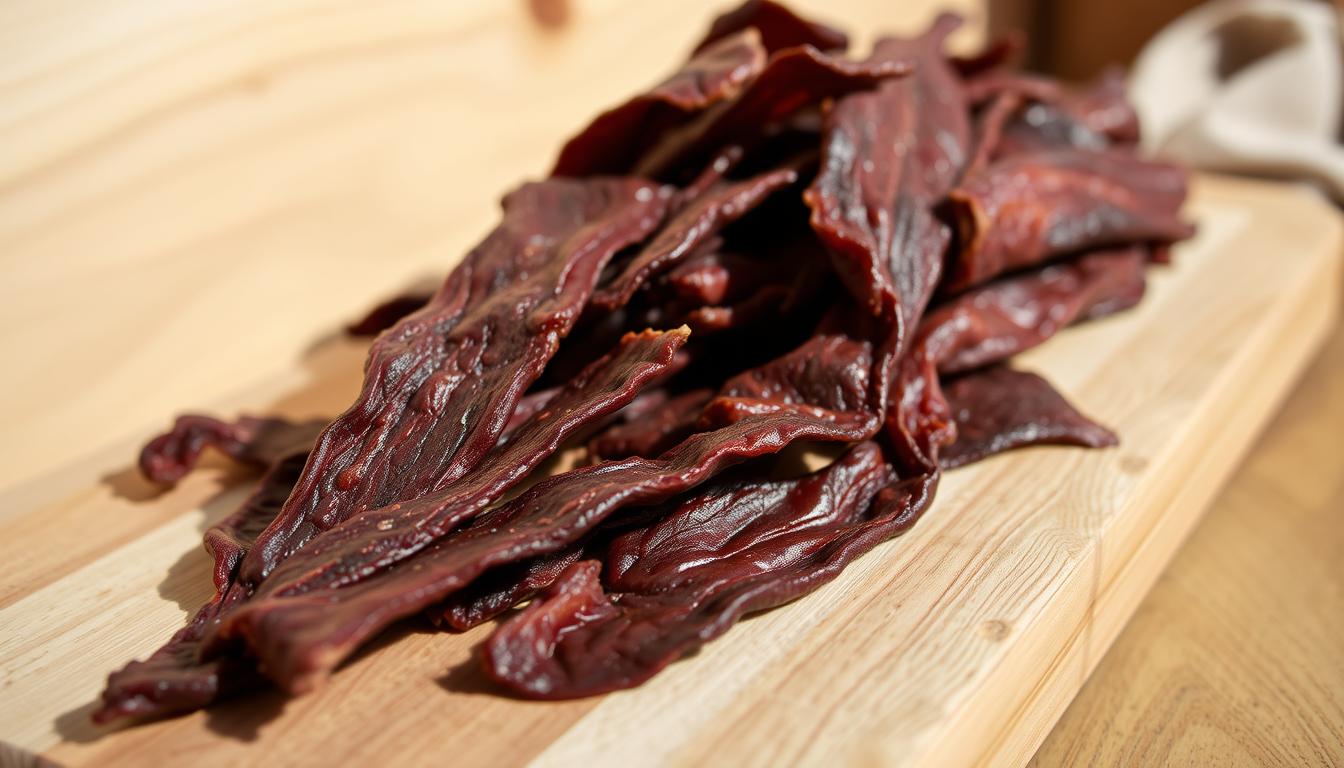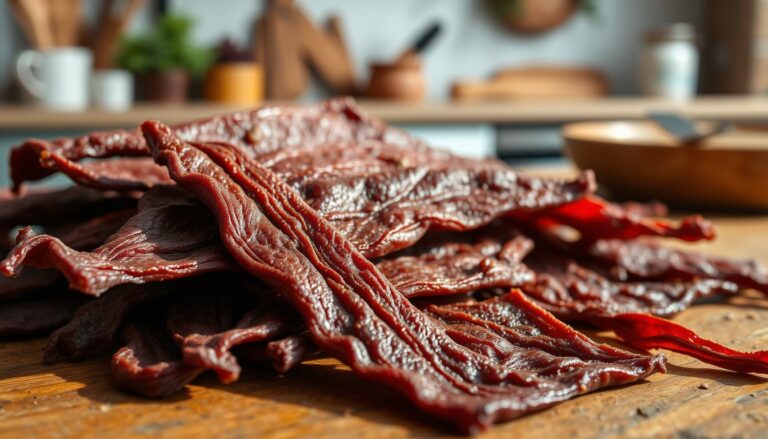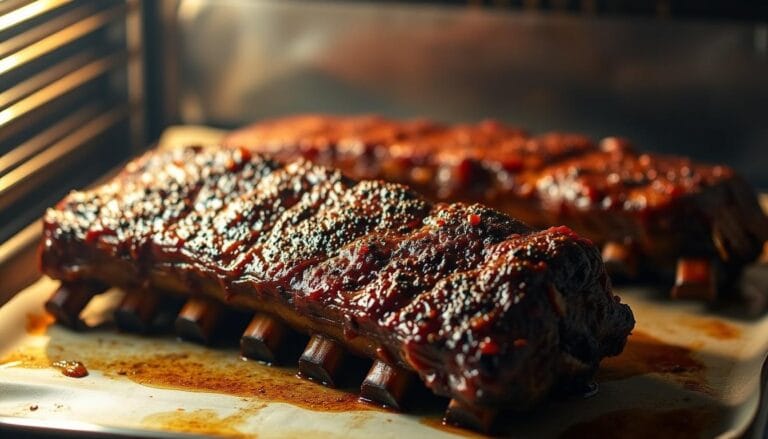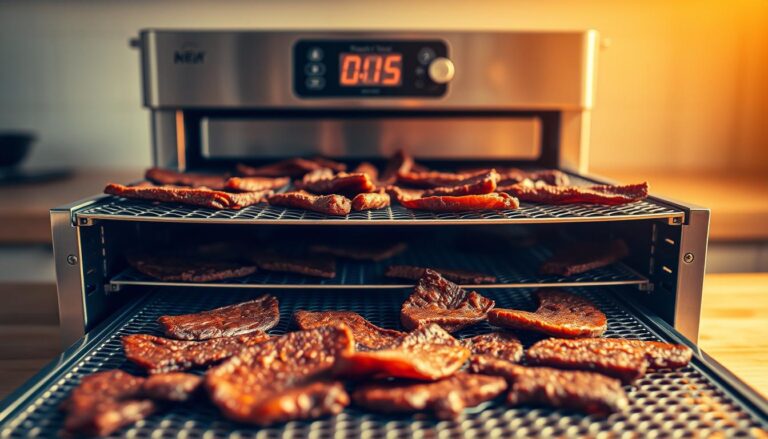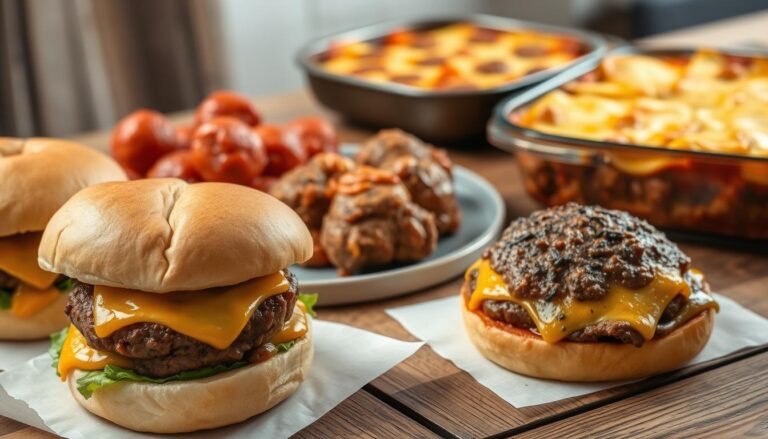Best Meat for Jerky: What to Choose
Table of Contents
Best Meat for Jerky: What to Choose
Making homemade jerky is a rewarding DIY project for snack lovers. It’s a simple process that combines low heat and smoke to create a flavorful, protein-packed treat. The key to success lies in choosing the right cut of meat.
During dehydration, the meat loses 50-75% of its weight, intensifying its flavor. This makes leanness and fat content critical factors. Lean cuts ensure a chewy texture, while minimal fat prevents spoilage during storage.
Understanding the right cut and preparation method can elevate your beef jerky game. Whether you’re using a smoker or an oven, the process requires patience and attention to detail. Consulting a butcher can also provide personalized advice for your recipe.
This guide will walk you through the essentials, from selecting the perfect meat to mastering the dehydration process. Let’s dive in and explore how to create the ultimate jerky at home.
Key Takeaways
- Choosing lean cuts ensures the ideal texture for jerky.
- Minimal fat content prevents spoilage during storage.
- Dehydration reduces meat weight by 50-75%, intensifying flavor.
- Low heat and smoke are essential for the dehydration process.
- Consulting a butcher can provide tailored advice for your recipe.
Introduction to Making Homemade Jerky
Crafting your own snacks at home has never been more rewarding. Homemade jerky is a timeless tradition, rooted in ancient preservation methods. Centuries ago, people dried meat to extend its shelf life, creating a portable, protein-rich food. Today, this process has evolved into a fun and flavorful DIY project.
Store-bought options often contain high levels of sodium and preservatives. By making your own, you control the ingredients, ensuring a healthier snack. You can adjust the flavor to suit your taste, whether you prefer smoky, spicy, or sweet.
While beef is a popular choice, jerky can be made from various proteins. Venison, turkey, and even salmon offer unique flavors and textures. This versatility makes it a great option for experimenting with different recipes.
Creating jerky at home is also cost-effective. Premium store brands can be pricey, but with a few basic tools, you can produce high-quality snacks for a fraction of the cost. Plus, it’s a fantastic activity to enjoy with your family. Kids can help with marinating or slicing, making it a fun and educational experience.
To get started, you’ll need a smoker or dehydrator, a sharp knife for slicing, and marinade tools. With these essentials, you’re ready to embark on your making jerky journey. Whether it’s for personal enjoyment or as a unique gift, homemade jerky is a delicious and satisfying project.
What Happens to Meat When Making Jerky
Understanding the transformation of meat during dehydration is key to perfecting your jerky. The process involves removing up to 75% of its weight, primarily through moisture loss. This intensifies the flavor and creates the chewy texture you love.
Low-temperature smoking, typically around 160°F, plays a dual role. It not only removes moisture but also infuses the cut with smoky flavor. This combination enhances taste while preserving the meat for longer storage.
Fat content is another critical factor. While intramuscular fat can add flavor, excessive fat can oxidize and lead to rancidity. Proper drying prevents bacterial growth, ensuring your jerky stays fresh for months.
Texture changes occur as collagen breaks down during the drying process. This results in the firm, chewy consistency that defines great jerky. Commercial producers often use large-scale drying timelines to achieve consistent results.
“The science behind jerky-making lies in balancing moisture removal, flavor infusion, and texture transformation.”
By understanding these changes, you can create jerky that’s not only delicious but also safe to store. Whether you’re a beginner or a seasoned pro, mastering this process will elevate your homemade snacks.
Key Characteristics of the Best Meat for Jerky
The quality of your jerky starts with the characteristics of the meat. Choosing the right cut ensures the perfect balance of texture, flavor, and longevity. Focus on three essential traits: leanness, low fat content, and a consistent shape.
Lean Cuts Are Essential
Lean cuts are the backbone of great jerky. According to USDA standards, beef labeled as lean contains less than 10% fat. Venison, with only 2% fat, is an excellent choice compared to pork, which can have 10-15% fat. The absence of excess fat ensures a chewy texture and prevents spoilage.
Connective tissue also plays a role. Too much can make jerky tough, while too little may result in a brittle texture. Aim for cuts with moderate connective tissue for the ideal chew.
Low Fat Content for Long Shelf Life
Fat content directly impacts shelf life. Fatty cuts spoil three times faster than lean ones. For example, jerky made from fatty meat may last only two weeks, while lean jerky can stay fresh for up to two months.
To trim fat effectively, use a boning knife or chill the meat before slicing. Removing visible fat ensures your jerky stays fresh and flavorful.
Consistent Shape for Even Slicing
Uniform slices are crucial for even drying. Aim for a thickness of 1/4 inch to ensure consistent results. Cylindrical cuts like eye round are easier to slice than flat cuts like flank steak.
For precision, consider using a meat slicer. This tool helps achieve even slices, reducing the risk of over- or under-drying. Consistent shape not only improves texture but also enhances the overall flavor of your jerky.
Top 5 Beef Cuts for Homemade Jerky
Selecting the right beef cuts can make or break your homemade jerky. Each cut offers unique characteristics that influence texture, flavor, and ease of preparation. Below, we explore five top choices that deliver exceptional results.
Eye of Round: The Jerky Maker’s Favorite
The eye round is a rear leg muscle from the round primal. Its natural cylindrical shape makes slicing straightforward, ensuring uniform pieces. Priced between $4-$6 per pound, it’s a budget-friendly option for consistent results.
Sirloin Tip Roast: A Hidden Gem
Often overlooked, the sirloin tip is a versatile cut with moderate marbling. USDA Select grade is recommended for optimal flavor and tenderness. Consulting your butcher can help you source the best quality for your recipe.
Top Round (London Broil): The Commercial Choice
Popular in commercial production, the top round offers efficiency and cost savings. It’s about 20% cheaper than the eye round, making it a practical choice for large batches. Its lean profile ensures a chewy texture.
Bottom Round: Affordable and Flavorful
The bottom round is another economical option. While it has more connective tissue, proper trimming enhances its flavor intensity. It’s a great alternative for those seeking bold taste without breaking the bank.
Flank Steak: Bold and Beefy
Known for its robust flavor, flank steak is ideal for those who enjoy a beefy profile. Cutting against the grain ensures tenderness, while pairing it with bold marinades like chipotle or bourbon elevates its taste.
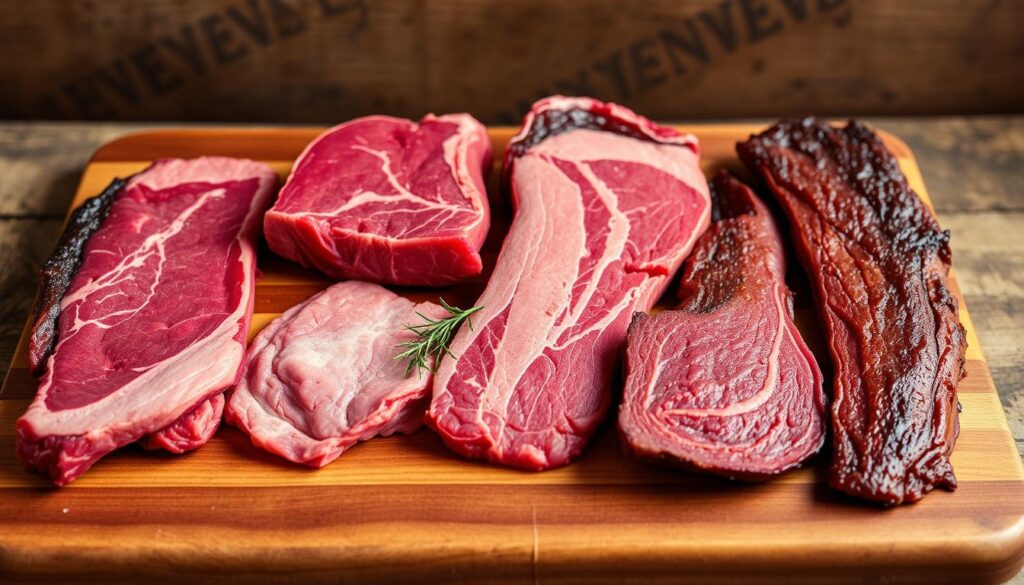
“The right cut transforms jerky from ordinary to extraordinary. Focus on leanness, texture, and flavor to achieve perfection.”
Experimenting with these cuts allows you to discover your favorite. Whether you prefer the affordability of the bottom round or the boldness of flank steak, each option brings something unique to the table.
Other Types of Meat That Work Well for Jerky
Exploring beyond beef opens up a world of possibilities for your homemade snacks. While beef is a classic choice, other proteins like venison, pork, and even salmon can create unique and flavorful jerky. These options cater to different tastes and dietary preferences, making your recipes more versatile.
Venison: A Gamey Alternative
Venison, a popular choice among hunters, offers a rich, gamey flavor that stands out. Proper field dressing is crucial to preserve its natural taste. Freeze-thaw cycles can also enhance tenderness, making it easier to slice and prepare.
- Field dressing ensures the flavor remains intact.
- Freeze-thaw cycles improve texture for slicing.
Turkey and Pork: Lean and Versatile
For a leaner option, turkey and pork are excellent choices. Brining helps retain moisture, especially in poultry, which can dry out during dehydration. Always ensure turkey reaches the USDA-safe temperature of 165°F to guarantee safety.
- Brining keeps the meat moist during drying.
- Follow USDA guidelines for safe cooking temperatures.
Salmon: A Seafood Twist
If you’re looking for a seafood option, salmon is a fantastic pick. Cold-smoking preserves its omega-3 fatty acids, while hot-smoking adds a deeper flavor. Both techniques create a unique jerky that’s rich in nutrients and taste.
- Cold-smoking retains omega-3s for a healthier snack.
- Hot-smoking enhances the flavor profile.
“Experimenting with different proteins can transform your jerky-making experience. Each type brings its own unique flavor and texture to the table.”
Whether you’re a fan of wild game or prefer the versatility of poultry and seafood, these alternatives offer endless opportunities to customize your recipes. Try them out and discover your new favorite!
How to Prepare Meat for Jerky
Preparing the perfect jerky starts with mastering the basics of meat preparation. Proper trimming, slicing, and marinating are essential steps to achieve the ideal texture and flavor. Each step ensures your final product is both delicious and long-lasting.
Trimming Fat and Connective Tissue
Lean cuts are crucial for jerky, but even the best cuts may need some trimming. Use the chill-to-firm technique to make clean cuts. Chill the meat in the freezer for 20-30 minutes before trimming. This makes it easier to remove excess fat and connective tissue.
Don’t discard the trimmings! They can be used to make flavorful broths or stocks. This reduces waste and maximizes the value of your purchase.
Slicing Against the Grain for Tenderness
To ensure tender jerky, always slice meat against the grain. This breaks down muscle fibers, making each piece easier to chew. For thicker cuts, slice at a 45° angle to create uniform pieces.
If you’re new to slicing, try the freezer partial-freeze method. Partially freeze the meat for 1-2 hours to make it firmer and easier to handle. This technique is especially helpful for beginners.
Marinating for Maximum Flavor
A good marinade is the key to flavorful jerky. The pH balance of your marinade matters. Acidic ingredients like vinegar or citrus juice help tenderize the meat while enhancing flavor. However, avoid over-marinating, as it can make the texture mushy.
Here’s a quick guide to minimum soak times for different types of meat:
| Meat Type | Minimum Marinating Time |
|---|---|
| Beef | 4-6 hours |
| Venison | 6-8 hours |
| Turkey | 2-4 hours |
| Pork | 4-6 hours |
For the best results, marinate in the refrigerator to keep the meat safe from bacteria. Stir the marinade occasionally to ensure even flavor distribution.
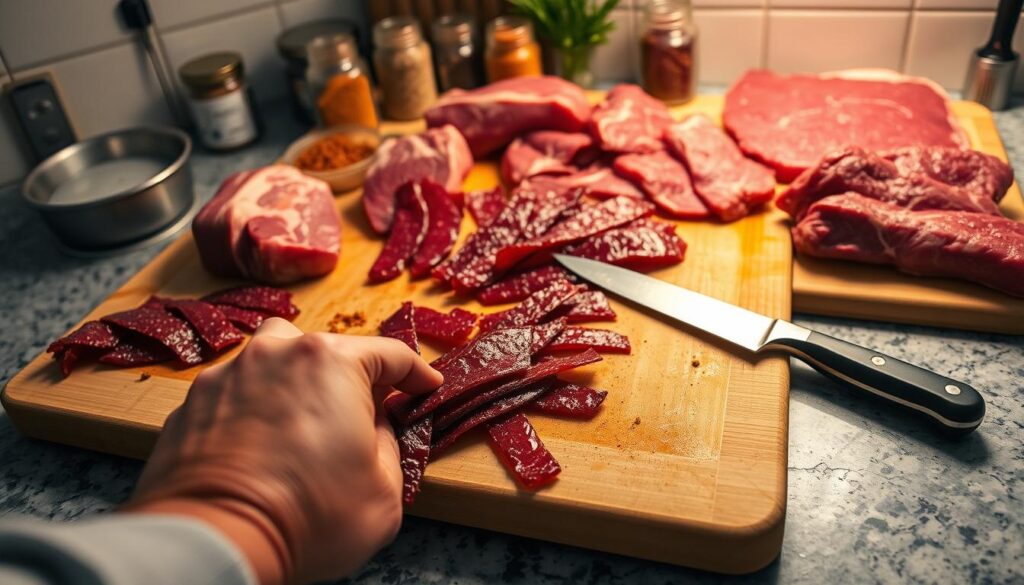
“Proper preparation transforms ordinary meat into extraordinary jerky. Focus on trimming, slicing, and marinating to achieve perfection.”
By following these steps, you’ll create jerky that’s flavorful, tender, and ready to enjoy. Whether you’re a beginner or an experienced maker, these tips will elevate your results.
Tips for Buying and Selecting Meat
Smart shopping is the first step to creating delicious homemade snacks. Whether you’re a beginner or a seasoned pro, knowing how to buy and select the right ingredients can make all the difference. From consulting your local butcher to taking advantage of seasonal sales, these tips will help you get the most out of your purchases.
Talk to Your Local Butcher
Your local butcher is a valuable resource when selecting cuts for homemade snacks. They can provide custom slicing requests, ensuring the perfect thickness for even drying. Access to primal cuts is another advantage, allowing you to save money while getting high-quality ingredients.
- Request custom slicing for uniform pieces.
- Primal cuts offer cost savings and flexibility.
Buy Fresh and in Sufficient Quantity
When you buy fresh, look for bright red color indicators. Grayish tones may indicate older stock. Vacuum-sealed packaging is often fresher than tray-packed options, as it reduces exposure to air and bacteria. Purchasing in the right amount ensures you have enough for your recipe without waste.
- Bright red meat is fresher than grayish cuts.
- Vacuum-sealed packaging maintains freshness longer.
Look for Sales and Specials
Seasonal sales can help you save money on high-quality cuts. Post-holiday periods often see price dips on beef, making it an ideal time to stock up. Proper freezer storage practices, like using airtight containers, ensure your purchases stay fresh until you’re ready to use them.
- Take advantage of post-holiday price drops.
- Store meat in airtight containers to maintain quality.
“Smart buying strategies not only save money but also ensure the quality of your homemade snacks. Focus on freshness, quantity, and timing to elevate your results.”
By following these tips, you’ll set yourself up for success in your home kitchen. Whether you’re shopping at your local butcher or taking advantage of seasonal sales, these strategies will help you create delicious snacks every time.
Conclusion: Start Your Jerky-Making Journey
Ready to elevate your snack game? Start your jerky-making journey today. Focus on lean cuts, low fat content, and consistent slicing for the best results. These key steps ensure your jerky has the perfect texture and flavor.
Experiment with marinades to find your favorite way to enhance taste. Try bold flavors like chipotle or sweet options like honey garlic. Keep a journal to track your recipes and adjustments for each batch. This helps you refine your process over time.
Engage with the community by sharing your creations in the comments section. Learn from others and exchange tips to improve your skills. Finally, always store your jerky in a cool, dry place to maintain freshness and safety.
Take the first step and make jerky at home. It’s a rewarding and delicious way to enjoy a protein-packed snack. Happy drying!
FAQ
What are the key characteristics of the best beef for jerky?
Which beef cuts are most recommended for making jerky?
Can I use other types of meat besides beef for jerky?
How should I prepare the meat before making jerky?
What tips should I follow when buying meat for jerky?
Why is it important to slice meat against the grain?
How long should I marinate the meat?
Can I use ground meat for jerky?
For more cooking tips, stay connected with us. We also recommend the cookbook Skinnytaste Simple: Easy, Healthy Recipes with 7 Ingredients or Fewer
For more Recipes about Beef?

